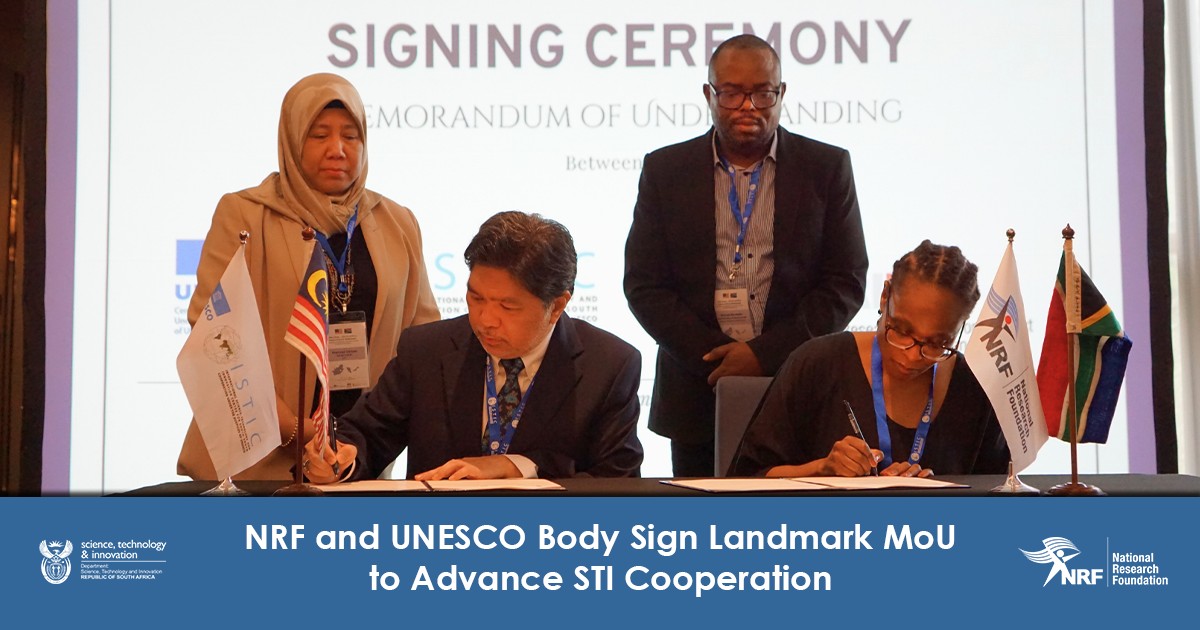NRF, ISTIC and UNESCO Forge STI Pact to Boost Research in Global South
The agreement marks a landmark in South-South scientific diplomacy, bringing together institutions from the Global South to tackle shared development challenges through joint STI programmes.

- Country:
- South Africa
In a major milestone for South-South cooperation in science, technology, and innovation (STI), a new partnership has been formalised between the National Research Foundation (NRF) of South Africa, the International Science, Technology and Innovation Centre for South-South Cooperation (ISTIC), and the United Nations Educational, Scientific and Cultural Organisation (UNESCO). The three institutions signed a Memorandum of Understanding (MoU) during a high-level ceremony in Kuala Lumpur, Malaysia, signalling a bold step toward joint research collaboration, capacity building, and knowledge sharing for sustainable development.
The MoU was signed by Dr Nare Prudence Makhura, Executive Director of International Grants and Partnerships at the NRF, in the presence of senior officials, researchers, and institutional partners from both Malaysia and South Africa.
A South-South Alliance for Science and Sustainable Development
The agreement marks a landmark in South-South scientific diplomacy, bringing together institutions from the Global South to tackle shared development challenges through joint STI programmes. It aligns with broader efforts under UNESCO to use science as a tool for peace, equity, and sustainability.
ISTIC, operating under the auspices of UNESCO, is a premier international platform dedicated to building institutional excellence and supporting scientific capacity development in the Global South. Through this new collaboration, ISTIC and NRF will pool their strengths to:
-
Foster collaborative, interdisciplinary research
-
Develop the capacity of early- and mid-career researchers
-
Promote exchange of scientific knowledge and innovations
-
Mobilise resources for high-impact STI projects
“This strategic partnership reaffirms our shared commitment to advancing inclusive and sustainable development through science, technology and innovation,” said Tengku Sharizad Tengku Dahlan, Director of ISTIC.
Priority Areas for Joint Research and Innovation
The MoU outlines several priority research areas that align with global and national development goals, including:
-
Water security and sustainable resource management
-
Health innovations and disease prevention
-
Climate change adaptation and mitigation
-
Artificial intelligence and digital technologies
-
Other mutually beneficial, frontier science disciplines
The parties committed to issuing joint calls for research proposals, co-hosting scientific symposia and workshops, and producing knowledge products such as policy briefs, toolkits, and collaborative research outputs.
“We look forward to nurturing a robust ecosystem of innovation and excellence,” said Michael Nxumalo, NRF Director of International Grants and Partnerships. “This MoU allows us to deepen ties between scientific communities across the Global South and develop real, evidence-based solutions.”
Strengthening Capacity Through Co-Creation and Training
A key goal of the agreement is to build scientific capacity in emerging economies, with a particular emphasis on developing researchers, especially women and youth. Through fellowships, joint training, mentorships, and academic exchange programmes, the MoU aims to strengthen human capital in the STI sectors.
These initiatives will not only bridge knowledge gaps but also create opportunities for co-creation, enabling researchers from different countries to work together on complex global issues.
“Together, ISTIC and NRF will create opportunities for knowledge exchange and impactful joint initiatives across the Global South,” added Tengku Sharizad.
Setting the Stage for Broader Collaboration
Beyond the current agreement, the MoU paves the way for project-specific agreements, resource mobilisation, and multi-country cooperation. This includes forging connections with research institutions, universities, government agencies, and multilateral organisations across Africa, Asia, Latin America, and the Middle East.
The agreement is seen as a strategic lever for building resilience and achieving the UN Sustainable Development Goals (SDGs) through STI collaboration.
“This MoU highlights how institutions from the Global South can lead in shaping a more equitable and knowledge-driven future,” said Dr Makhura. “It is a demonstration of our collective will to harness science for the public good.”
UNESCO's Role: Science for Peace and Sustainability
As a co-signatory and long-time advocate for science diplomacy, UNESCO’s role in the partnership underscores its mission to promote international cooperation in education, science, culture, and communication. Through ISTIC and other regional initiatives, UNESCO supports member states in building science systems that are inclusive, ethical, and responsive to global needs.
This partnership reflects a shared belief that the next frontier of innovation lies in international collaboration, particularly among countries facing common development challenges.
As the NRF, ISTIC, and UNESCO launch this partnership, the scientific communities of the Global South are poised to benefit from a new era of collaboration — one that empowers local talent, strengthens global knowledge systems, and champions science as a driver of sustainable and inclusive growth.
ALSO READ
Military helicopter crashes at airport in Somalia capital
Singaporean Author Collaborates with AI to Propose a New Framework for Democracy for the World as Part of His Global Citizens' Manifesto Series
How AI can transform financial forecasting and decision-making in fintech environments
Ukrainian aid projects wither as Western funding drops
Bihar Polls: Defence Minister Rajnath Singh arrives at Patna airport ahead of inaugural ceremony of BJP's state executive meeting










